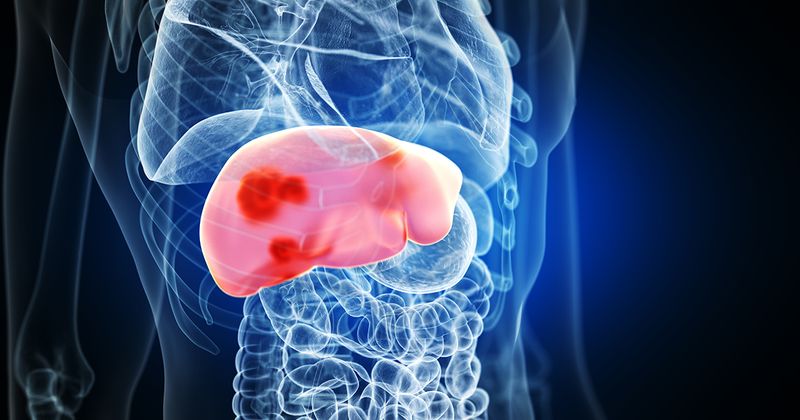DUET topline data: Terns’ THR-beta agonist drastically reduced liver fat content in NASH
Key takeaways:
- TERN-501 6 mg, a thyroid hormone receptor beta agonist, reduced liver fat content in patients with nonalcoholic steatohepatitis by 45% after 12 weeks.
- All doses of TERN-501 – 1 mg, 3 mg and 6 mg – were well tolerated.
Topline findings from the phase 2a DUET trial showed that Tern Pharmaceuticals’ oral thyroid hormone receptor-beta agonist achieved significant reductions in liver fat content among patients with nonalcoholic steatohepatitis.
The company reported that its THR-beta agonist product, TERN-501, administered either as a monotherapy or in combination with its liver-distributed farnesoid X receptor (FXR) agonist, TERN-101, demonstrated dose-dependent “statistically significant reductions” in liver fat content as assessed by MRI proton density fat fraction (MRI-PDFF).

“These strongly positive TERN-501 data are highly encouraging,” Erin Quirk, MD, president and head of research and development at Terns, told Healio. “They reinforce our belief in the potential of TERN-501 to be a novel, safe, effective and convenient once-daily oral therapy for NASH and support prior research indicating THR-β as an important mechanism of action for the treatment of this debilitating disease.”
Quirk continued: “We are hopeful that TERN-501 may be the THR-β monotherapy of choice for clinicians and possibly a key component of combination therapy regimens for NASH in the future and address the multi-faceted aspects of this disease to improve patients’ lives.”
This phase 2a data could place TERN-501 as a strong contender among rival drug developers with their own thyroid receptor-beta agonists for NASH in the pipeline, including Madrigal Pharmaceuticals and Viking Therapeutics.
TERN-501 doses vs. placebo
In the DUET phase 2a, multicenter, randomized, double-blind clinical trial, 160 patients with a BMI 25kg/m2 or greater and precirrhotic NASH were randomized to receive TERN-501 1 mg (n=23), 3 mg (n=19), 6 mg (n=22) or placebo (n=21).
All patients had liver fat content of ≥10% as confirmed by MRI-PDFF, and an MRI corrected T1 (cT1) relaxation time of 800 msec or greater.
The primary endpoint of the study was a relative MRI-PDFF change from baseline at 12 weeks for patients who received TERN-501 compared with placebo. Secondary endpoints included relative MRI-PDFF change from baseline for TERN-501 in combination with TERN-101, cT1 change from baseline for TERN-501 monotherapy vs. placebo, and TERN-501 in combination with TERN-101 vs. placebo.
‘Encouraging’ MRI-PDFF reduction
According to topline results, the primary endpoint was achieved in both the 3 mg and 6 mg TERN-501 groups, demonstrating dose dependence and statistically significant decreases in mean relative change from baseline in liver fat content.
“[We] observed dose dependent and statistically significant reductions in mean relative change from baseline in liver fat content as measured by MRI-PDFF, with a 45% reduction after treatment with TERN-501 6mg once daily compared to a 4% reduction with placebo at Week 12,” Quirk said.
All doses of TERN-501 monotherapy – 1 mg, 3 mg and 6 mg – achieved statistically higher proportions of patients with MRI-PDFF reduction of at least 30% vs. placebo (26%, 39%, 64% vs. 4%). According to the press release, a reduction in liver fat content of 30% has been correlated “with improvements in NASH when confirmed by liver biopsy.” TERN-501 monotherapy also demonstrated reduced mean change in cT1.
The researchers reported improvements in low-density lipoprotein cholesterol, high-density lipoprotein cholesterol, triglycerides and apolipoprotein B for the TERN-501 monotherapy groups. In addition, modest improvements in MRI-PDFF mean relative change and MRI-PDFF responder rates were reported for patients who received TERN-501 plus TERN-101 10 mg compared with TERN-501 monotherapy.
The finding that TERN-501 plus TERN-101 did not increase LDL from baseline at week 12 may suggest that TERN-501 was able to cancel out FXR-mediated LDL increases; according to the press release, “these results are supportive of the ability to administer TERN-501 in combination with FXR and potentially other therapeutics.”
“We are also particularly excited about the safety profile of TERN-501, including no gastrointestinal or cardiovascular safety signals, especially given safety concerns with others NASH therapies in development,” Quirk, told Healio.
Topline data demonstrated that TERN-501 was well tolerated, with mild adverse events across all treatment groups. No drug-related serious adverse events were observed; although GI events including diarrhea and vomiting were reported, no cardiovascular events were found.
Reference:
- Terns Pharmaceuticals Reports Second Quarter 2023 Financial Results and Corporate Updates. https://ir.ternspharma.com/news-releases/news-release-details/terns-pharmaceuticals-reports-second-quarter-2023-financial. Published August 8, 2023. Accessed August 9, 2023.
